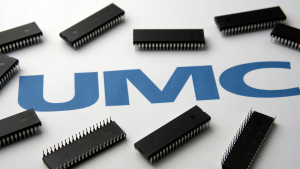For comparison, that made NVDA stock cheaper than its main competitor Advanced Micro Devices (NASDAQ:AMD), currently priced at $160 per share. With the new price tag perception of not being seen as “too expensive to get in”, Nvidia is likely to see further capital inflows despite already having the inkling of overbought-ness at 73.26 P/E.
On the broader AI semiconductor front, investors are still in the innings of the cycle. JPMorgan (NYSE:JPM) PB equity strategist Bruno de la Sota noted in April that this is a multi-year opportunity “just starting to show up in corporate bottom lines.”
But as Nvidia still dominates this focus, what are the chip stocks to buy after Nvidia split?
Arm Holdings PLC (ARM)

Available as American Depositary Shares (ADS), Arm Holdings (NASDAQ:ARM) is an ambitious British chip designer. By forgoing direct chip manufacturing, the company furthers cutting-edge architecture to license CPUs and GPUs to other companies.
This resulted in Arm’s dominant market share among embedded computing and mobile app segments, at 65% and over 90%, respectively. The royalty-based revenue has served Arm well, having increased its market cap to $163 billion.
Recently, Arm leadership hinted at greater ambitions. Within the Windows PC market, dominated by Nvidia, AMD and Intel (NASDAQ:INTC), Arm aims to capture over 50% of the market share over the next five years.
Arm CEO Rene Haas noted that is the most likely outcome from Microsoft’s (NASDAQ:MSFT) shift towards Arm-based chips as a strategy to tackle Apple (NASDAQ:AAPL). The latest manifestation of this trend was at the Microsoft Surface Copilot+ presentation featuring Qualcomm’s (NASDAQ:QCOM) Snapdragon X Elite and Plus chips, which follow Arm’s design.
In other words, as Apple and Microsoft giants battle it out, this benefits ARM shareholders. More vendors, like Dell (NYSE:DELL) and Asus, will further sell Arm-based machines. By the end of 2025, Arm sees 100 billion devices ready to power AI apps. In the last month, ARM stock was up 36% to $155.59. That is 74% over the stock’s 52-week average of $89.37 per share.
Micron Technology (MU)

At the end of May, Micro Technology (NASDAQ:MU) lost the Texas court battle over the memory module patent, potentially forcing Netlist (OTCMKTS:NLST) to pay up to $445 million in damages. When Netlist won a similar infringement case against Samsung in 2023, the company was forced to pay $303 million.
While the payment determination process is still ahead, MU stock managed to outperform the wider market at 13.4%, continuing its valuation spree of nearly 100% gains over one year. That’s because Micron is a key player in the supply of memory modules, from microSD cards to DRAM, NAND flash and multichip packages for enterprise-grade solutions.
In the high-bandwidth memory (HBM) arena now trending for AI infrastructure, Micron expects to see up to 25% market share by 2025, presently dominated by Samsung and SK Hynix. In addition to advanced HBM3e tech, which began production in February, Micron is actively developing the next-gen HBM4 memory lineup.
Regarding GPUs, customers will likely see Micron’s GDDR7 memory, facilitating over 50% energy efficiency improvement. That will go a long way in extending battery life for mobile devices but also power users’ AI and gaming needs.
Even if Micron has to fully pay Netlist, which is unlikely, it will be a minor bump in the road, as the company reported a 57.7% year-over-year revenue increase ending February 2024. From the present price of $140.75, MU stock is 63% above its 52-week average of $86.13 per share. Analysts put the average MU price target at $135.98 with the upper ceiling at $224.18 per share.
United Microelectronics Corporation (UMC)

Little-known Taiwanese United Microelectronics Corporation (NYSE:UMC) is a semiconductor company that manufactures integrated circuit (IC) solutions for telecom, IT and multimedia sectors across its multi-national foundries in Japan, Singapore, China and Taiwan.
Additionally, UMC invested in renewable energy solutions, having founded NexPower Technology in 2005, which manufactures the thin-film photovoltaic (PV) found in solar panels. After a slump in net sales during 2023, UMC turned around in February, followed by consecutive year-over-year growth each month up to May.
In its Q1 €˜24 earnings report, the company shipped 4.5% more wafers. UMC’s specialty business offset the minor drop in utilization rate by supplying silicon interposers for AI servers, RFSOI chips and power management ICs. Considering that UMC is a cyclical company, apparent from its net income figures over the years, the AI demand is pushing it to the start of a positive cycle.
Ahead of inventory replenishments in PCs and consumer electronics, UMC is finishing up its $5 billion expansion of Fab12i in Singapore for mass production in early 2026 as one of the most advanced foundries geared for 22 and 28-nm chip manufacturing.
At $8.74 per share, UMC stock is close to its 52-week high of $8.97, having remained relatively stable at an average price of $7.75 for the last 52 weeks. Investors looking into chip stocks to buy after the Nvidia split should take advantage of UMC’s relatively high dividend yield of 6.59% at a $0.58 annual payout per share.
On the date of publication, Shane Neagle did not hold (either directly or indirectly) any positions in the securities mentioned in this article. The opinions expressed in this article are those of the writer, subject to the InvestorPlace.com Publishing Guidelines.
Shane Neagle is fascinated by the ways in which technology is poised to disrupt investing. He specializes in fundamental analysis and growth investing.
